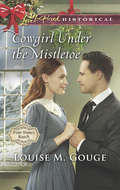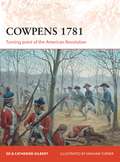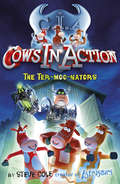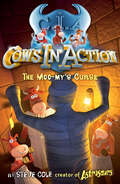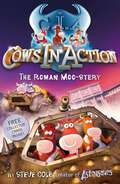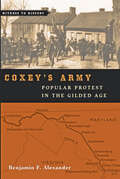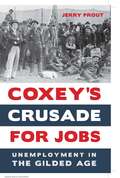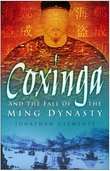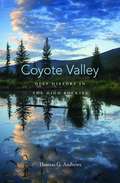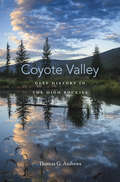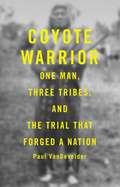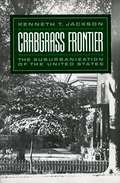- Table View
- List View
Cowgirl Under The Mistletoe: Pony Express Christmas Bride Cowgirl Under The Mistletoe A Family Arrangement Wed On The Wagon Train (Four Stones Ranch #4)
by Louise M. GougeA Colorado Christmas Courtship
Cowpens 1781: Turning point of the American Revolution (Campaign #283)
by Ed Gilbert Catherine GilbertThis is a blistering account of the battle of Cowpens, a short, sharp conflict which marked a crucial turning point in the American Revolution. With Lt. Col. Banastre Tarleton and the British troops in hot pursuit, Daniel Morgan, leading a small force of 700 Continentals and militia, chose the Cowpens as the battlefield in which to make a stand. The two forces clashed for barely more than 45 minutes, yet this brief battle shaped the outcome of the War in the South and decisively influenced the conflict as a whole. The authors provide a shrewd analysis of what was perhaps the finest tactical performance of the entire war. Bird's-eye views, vivid illustrations and detailed maps illuminate the dynamism of this clash between two of the most famous commanders of the War of Independence.
Cowpens 1781: Turning point of the American Revolution (Campaign)
by Graham Turner Ed Gilbert Catherine GilbertThis is a blistering account of the battle of Cowpens, a short, sharp conflict which marked a crucial turning point in the American Revolution. With Lt. Col. Banastre Tarleton and the British troops in hot pursuit, Daniel Morgan, leading a small force of 700 Continentals and militia, chose the Cowpens as the battlefield in which to make a stand. The two forces clashed for barely more than 45 minutes, yet this brief battle shaped the outcome of the War in the South and decisively influenced the conflict as a whole. The authors provide a shrewd analysis of what was perhaps the finest tactical performance of the entire war. Bird's-eye views, vivid illustrations and detailed maps illuminate the dynamism of this clash between two of the most famous commanders of the War of Independence.
Cows in Action 1: The Ter-moo-nators (Cows In Action #10)
by Steve ColeAnother hilarious, action-packed adventure from the Astro-nomically popular Steve Cole.Genius cow Professor McMoo and his trusty sidekicks, Pat and Bo, are the star agents of the C.I.A. - short for COWS IN ACTION! They travel through time, fighting evil bulls from the future and keeping history on the right track . . . When Professor McMoo invents a brilliant TIME MACHINE, he and his friends are soon attacked by a terrifying TER-MOO-NATOR - a deadly robo-cow who wants to mess with the past and change the future! And that's only the start of an incredible ADVENTURE that takes McMoo, Pat and Bo from a cow paradise in the future to the SCARY dungeons of King Henry VIII . . . It's time for action. COWS IN ACTIONPerfect for children ready to start reading chapter books by themselves.
Cows in Action 2: Cows In Action 2 (Cows In Action #7)
by Steve ColeAnother hilarious, action-packed adventure from the Astro-nomically popular Steve Cole.Genius cow Professor McMoo and his trusty sidekicks, Pat and Bo, are star agents of the C.I.A. - short for COWS IN ACTION! They travel through time, fighting evil bulls from the future and keeping history on the right track . . . In ANCIENT EGYPT, a monstrous moo-my has come to life and kicked the PHARAOH off his throne. Sent to investigate, the C.I.A agents face PERIL in the pyramids and nightmares on the Nile. Can they foil a TERRIFYING time-crime before the whole WORLD falls to the moo-my's curse?It's time for action. COWS IN ACTIONAnother UDDERLY hilarious title featuring the intrepid Professor McMoo and his team of time-travelling cows - perfect for children ready to start reading chapter books by themselves.
Cows in Action 3: The Roman Moo-stery (Cows In Action #9)
by Steve ColeAnother hilarious, action-packed adventure from the Astro-nomically popular Steve Cole.Genius cow Professor McMoo and his trusty sidekicks, Pat and Bo, are star agents of the C.I.A. - short for COWS IN ACTION! They travel through time, fighting evil bulls from the future and keeping history on the right track . . .The C.I.A. travel back to the ROMAN EMPIRE, where TER-MOO-NATORS are turning innocent bulls into WARRIORS! With all Rome at risk, Mc Moo, Pat and Bo battle GLADIATORS and race to the death in CHARIOTS, trying to solve a moo-stery that could wreck history FOR EVER!It's time for action. COWS IN ACTION.
Coxey's Army: Popular Protest in the Gilded Age (Witness to History)
by Benjamin F. AlexanderIn 1893, after a major British bank failure, a run on U.S. gold reserves, and a late-June stock-market crash, America was in the throes of a serious economic depression. Unemployment rose, foreclosures climbed, and popular unrest mounted. By the following spring, businessman and Populist agitator Jacob S. Coxey was fed up with government inactivity in the face of the crisis. With the help of eccentric showman Carl Browne, he led a group of several hundred unemployed wage earners, small farmers, and crossroads merchants on a march from Massillon, Ohio, to Washington, D.C., to present a "petition in boots" for government-financed jobs building and repairing the nation’s roads. On May 1, the Coxeyites descended on the center of government, where Coxey attempted to deliver a speech on the Capitol steps. The police attacked, a melee ensued, and Coxey and Browne spent a month in jail. Meanwhile, other Coxey-inspired contingents were on their way east from places as far away as San Francisco and Portland. Some of them even hijacked trains along the way. Who was Coxey, and what motivated himâ€�along with the angry marchers who joined his cause? What did other Americans think of the protesters? Was there ever any chance that the protesters’ demands would be met? Where did the agitators fit in with the politics of their day, and how did their actions jibe with the other labor-related protests happening that year? In this concise and gripping narrative, Benjamin F. Alexander contextualizes the march by vividly describing the misery wrought by the Panic of ’93. Alexander brings both Coxey and his fellow leaders to life, along with the reporters and spies who traveled with them and the diverse group of captivated newspaper readers who followed the progress of the marches and train heists.Coxey’s Army explains how the demands of the Coxeyitesâ€�far from being the wild schemes of a small group of cranksâ€�fit into a larger history of economic theories that received serious attention long before and long after the Coxey march. Despite running a gauntlet of ridicule, the marchers laid down a rough outline of what, some forty years later, emerged as the New Deal.
Coxey’s Crusade for Jobs: Unemployment in the Gilded Age
by Jerry ProutIn the depths of a depression in 1894, a highly successful Gilded Age businessman named Jacob Coxey led a group of jobless men on a march from his hometown of Massillon, Ohio, to the steps of the nation's Capitol. Though a financial panic and the resulting widespread business failures caused millions of Americans to be without work at the time, the word unemployment was rarely used and generally misunderstood. In an era that worshipped the self-reliant individual who triumphed in a laissez-faire market, the out-of-work "tramp" was disparaged as weak or flawed, and undeserving of assistance. Private charities were unable to meet the needs of the jobless, and only a few communities experimented with public works programs. Despite these limitations, Coxey conceived a plan to put millions back to work building a nationwide system of roads and drew attention to his idea with the march to Washington. In Coxey's Crusade for Jobs, Jerry Prout recounts Coxey's story and adds depth and context by focusing on the reporters who were embedded in the march. Their fascinating depictions of life on the road occupied the headlines and front pages of America's newspapers for more than a month, turning the spectacle into a serialized drama. These accounts humanized the idea of unemployment and helped Americans realize that in a new industrial economy, unemployment was not going away and the unemployed deserved attention. This unique study will appeal to scholars and students interested in the Gilded Age and US and labor history.
Coxinga and the Fall of the Ming Dynasty: Coxinga And The Fall Of The Ming Dynasty
by Jonathan ClementsThis is the fantastic true story of the infamous pirate; Coxinga who became king of Taiwan and was made a god - twice. From humble origins, Coxinga's father became the richest man in China and Admiral of the Emperor's navy during the Ming Dynasty. As his eldest son, Coxinga was given the best education and developed a love of poetry and the study of Confucius. From this unlikely beginning, it took the invasion of south China by the Manchu and the subsequent loss of both his parents - his father defected to the Manchu and his mother, a Japanese Samurai, died in battle - to turn Coxinga from scholar to warrior. Fiercely loyal to his exiled Emperor, Coxinga fought against overwhelming odds until his defeat drove him out to sea and over to Taiwan - at the time a lawless set of islands inhabited by cannibals. Self-styled king of Taiwan, Coxinga died at the moment of his triumph. His descendants ruled the island for two decades.
Cox's Fragmenta: An Historical Miscellany (History Press Ser.)
by Simon MurphyErotic misdemeanours in an Irish bean-field, the recipe for a frog barometer fresh from the French court, a parrot convicted of heresy and burnt at the stake in Spain and a Dutch stage effect for ejecting a wig (by means of a spring) during Hamlet’s ghost scene are just some of the masterpieces of understated journalism collected by Francis Cox and contained in his Fragmenta. At ninety-seven volumes, Cox’s scrapbook has to be one of the largest collections of journalistic ephemera ever. For sixty years during the late eighteenth and early nineteenth centuries he accumulated articles on everything from duels to playhouses, and foreign travel to warfare. Simon Murphy has selected the most amusing and bizarre to create an historical miscellany which will intrigue and delight.
Cox's Fragmenta II: Further Folios from History
by Simon MurphyA presumptuous bear imposing on a coachful of ladies, how to behave in the British Museum, the dangers of dallying with a black-eyed girl and the Royal Navy’s inaugural biscuit machine are just some of the masterpieces of understated journalism collected by Francis Cox and contained in his Fragmenta. At ninety-four volumes, Cox’s scrapbook has to be one of the largest collections of journalistic ephemera ever. For sixty years during the late eighteenth and early nineteenth centuries he accumulated articles on everything from duels to playhouses, and foreign travel to warfare. Following on from the success of the first volume, Simon Murphy has selected more bizarre stories to create another delightful historical miscellany which will intrigue and amuse.
Coxsackie: The Life and Death of Prison Reform (Reconfiguring American Political History)
by Joseph F. SpillaneShould prisons attempt reform and uplift inmates or, by means of principled punishment, deter them from further wrongdoing? This debate has raged in Western Europe and in the United States at least since the late eighteenth century. Joseph F. Spillane examines the failure of progressive reform in New York State by focusing on Coxsackie, a New Deal reformatory built for young male offenders. Opened in 1935 to serve "adolescents adrift," Coxsackie instead became an unstable and brutalizing prison. From the start, the liberal impulse underpinning the prison’s mission was overwhelmed by challenges it was unequipped or unwilling to face—drugs, gangs, and racial conflict.Spillane draws on detailed prison records to reconstruct a life behind bars in which "ungovernable" young men posed constant challenges to racial and cultural order. The New Deal order of the prison was unstable from the start; the politics of punishment quickly became the politics of race and social exclusion, and efforts to save liberal reform in postwar New York only deepened its failures. In 1977, inmates took hostages to focus attention on their grievances. The result was stricter discipline and an end to any pretense that Coxsackie was a reform institution.Why did the prison fail? For answers, Spillane immerses readers in the changing culture and racial makeup of the U.S. prison system and borrows from studies of colonial prisons, which emblematized efforts by an exploitative regime to impose cultural and racial restraint on others.In today’s era of mass incarceration, prisons have become conflict-ridden warehouses and powerful symbols of racism and inequality. This account challenges the conventional wisdom that America’s prison crisis is of comparatively recent vintage, showing instead how a racial and punitive system of control emerged from the ashes of a progressive ideal.
Coxsackie: The Life and Death of Prison Reform (Reconfiguring American Political History)
by Joseph F. SpillaneShould prisons attempt reform and uplift inmates or, by means of principled punishment, deter them from further wrongdoing? This debate has raged in Western Europe and in the United States at least since the late eighteenth century. Joseph F. Spillane examines the failure of progressive reform in New York State by focusing on Coxsackie, a New Deal reformatory built for young male offenders. Opened in 1935 to serve "adolescents adrift," Coxsackie instead became an unstable and brutalizing prison. From the start, the liberal impulse underpinning the prison’s mission was overwhelmed by challenges it was unequipped or unwilling to faceâ€�drugs, gangs, and racial conflict.Spillane draws on detailed prison records to reconstruct a life behind bars in which "ungovernable" young men posed constant challenges to racial and cultural order. The New Deal order of the prison was unstable from the start; the politics of punishment quickly became the politics of race and social exclusion, and efforts to save liberal reform in postwar New York only deepened its failures. In 1977, inmates took hostages to focus attention on their grievances. The result was stricter discipline and an end to any pretense that Coxsackie was a reform institution.Why did the prison fail? For answers, Spillane immerses readers in the changing culture and racial makeup of the U.S. prison system and borrows from studies of colonial prisons, which emblematized efforts by an exploitative regime to impose cultural and racial restraint on others.In today’s era of mass incarceration, prisons have become conflict-ridden warehouses and powerful symbols of racism and inequality. This account challenges the conventional wisdom that America’s prison crisis is of comparatively recent vintage, showing instead how a racial and punitive system of control emerged from the ashes of a progressive ideal.
Coyote America: A Natural and Supernatural History
by Dan FloresThe New York Times best-selling account of how coyotes--long the target of an extermination policy--spread to every corner of the United States Finalist for the PEN/E.O. Wilson Literary Science Writing Award"A masterly synthesis of scientific research and personal observation." -Wall Street JournalLegends don't come close to capturing the incredible story of the coyote In the face of centuries of campaigns of annihilation employing gases, helicopters, and engineered epidemics, coyotes didn't just survive, they thrived, expanding across the continent from Alaska to New York. In the war between humans and coyotes, coyotes have won, hands-down. Coyote America is the illuminating five-million-year biography of this extraordinary animal, from its origins to its apotheosis. It is one of the great epics of our time.
Coyote Nation: Sexuality, Race, and Conquest in Modernizing New Mexico, 1880-1920 (Worlds of Desire: The Chicago Series on Sexuality, Gender, and Culture)
by Pablo MitchellWith the arrival of the transcontinental railroad in the 1880s came the emergence of a modern and profoundly multicultural New Mexico. Native Americans, working-class Mexicans, elite Hispanos, and black and white newcomers all commingled and interacted in the territory in ways that had not been previously possible. But what did it mean to be white in this multiethnic milieu? And how did ideas of sexuality and racial supremacy shape ideas of citizenry and determine who would govern the region? Coyote Nation considers these questions as it explores how New Mexicans evaluated and categorized racial identities through bodily practices. Where ethnic groups were numerous and—in the wake of miscegenation—often difficult to discern, the ways one dressed, bathed, spoke, gestured, or even stood were largely instrumental in conveying one's race. Even such practices as cutting one's hair, shopping, drinking alcohol, or embalming a deceased loved one could inextricably link a person to a very specific racial identity. A fascinating history of an extraordinarily plural and polyglot region, Coyote Nation will be of value to historians of race and ethnicity in American culture.
Coyote Nation: Sexuality, Race, and Conquest in Modernizing New Mexico, 1880-1920 (Worlds of Desire: The Chicago Series on Sexuality, Gender, and Culture)
by Pablo MitchellWith the arrival of the transcontinental railroad in the 1880s came the emergence of a modern and profoundly multicultural New Mexico. Native Americans, working-class Mexicans, elite Hispanos, and black and white newcomers all commingled and interacted in the territory in ways that had not been previously possible. But what did it mean to be white in this multiethnic milieu? And how did ideas of sexuality and racial supremacy shape ideas of citizenry and determine who would govern the region? Coyote Nation considers these questions as it explores how New Mexicans evaluated and categorized racial identities through bodily practices. Where ethnic groups were numerous and—in the wake of miscegenation—often difficult to discern, the ways one dressed, bathed, spoke, gestured, or even stood were largely instrumental in conveying one's race. Even such practices as cutting one's hair, shopping, drinking alcohol, or embalming a deceased loved one could inextricably link a person to a very specific racial identity. A fascinating history of an extraordinarily plural and polyglot region, Coyote Nation will be of value to historians of race and ethnicity in American culture.
Coyote Nation: Sexuality, Race, and Conquest in Modernizing New Mexico, 1880-1920 (Worlds of Desire: The Chicago Series on Sexuality, Gender, and Culture)
by Pablo MitchellWith the arrival of the transcontinental railroad in the 1880s came the emergence of a modern and profoundly multicultural New Mexico. Native Americans, working-class Mexicans, elite Hispanos, and black and white newcomers all commingled and interacted in the territory in ways that had not been previously possible. But what did it mean to be white in this multiethnic milieu? And how did ideas of sexuality and racial supremacy shape ideas of citizenry and determine who would govern the region? Coyote Nation considers these questions as it explores how New Mexicans evaluated and categorized racial identities through bodily practices. Where ethnic groups were numerous and—in the wake of miscegenation—often difficult to discern, the ways one dressed, bathed, spoke, gestured, or even stood were largely instrumental in conveying one's race. Even such practices as cutting one's hair, shopping, drinking alcohol, or embalming a deceased loved one could inextricably link a person to a very specific racial identity. A fascinating history of an extraordinarily plural and polyglot region, Coyote Nation will be of value to historians of race and ethnicity in American culture.
Coyote Steals Fire: A Shoshone Tale
by Northwestern Shoshone Nation"Coyote was tired of being cold," begins this traditional Shoshone tale about the arrival of fire in the northern Wasatch region. Members of the Northwestern Band of the Shoshone Nation developed the concept for this retelling, in collaboration with book arts teacher, Tamara Zollinger. Together, they wrote and illustrated the book. Bright watercolor-and-salt techniques provide a winning background to the hand-cut silhouettes of the characters. The lively, humorous story about Coyote and his friends is complemented perfectly by later pages written by Northwestern Shoshone elders on the historical background and cultural heritage of the Shoshone nation. An audio CD with the voice of Helen Timbimboo telling the story in Shoshone and singing two traditional songs makes this book not only good entertainment but an important historical document, too. Sure to delight readers of all ages, Coyote Steals Fire will be a valuable addition to the family bookshelf, the elementary classroom, the school or public library.
Coyote Valley: Deep History in the High Rockies
by Thomas G. AndrewsThomas Andrews drills deep into the many pressures that have reshaped a small stretch of North America, from the ice age to the advent of the Anthropocene and controversies over climate change. He brings to the surface lessons about the critical relationships to land, climate, and species that only seemingly unimportant places on Earth can teach.
Coyote Valley: Deep History in the High Rockies
by Thomas G. AndrewsThomas Andrews drills deep into the many pressures that have reshaped a small stretch of North America, from the ice age to the advent of the Anthropocene and controversies over climate change. He brings to the surface lessons about the critical relationships to land, climate, and species that only seemingly unimportant places on Earth can teach.
Coyote Warrior: One Man, Three Tribes, and the Trial That Forged a Nation
by Paul Van DevelderA Civil Action meets Indian country, as one man takes on the federal government and the largest boondoggle in U.S. history -- and wins.
Crabgrass Frontier: The Suburbanization of the United States
by Kenneth T. JacksonThis first full-scale history of the development of the American suburb examines how "the good life" in America came to be equated with the a home of one's own surrounded by a grassy yard and located far from the urban workplace. Integrating social history with economic and architectural analysis, and taking into account such factors as the availability of cheap land, inexpensive building methods, and rapid transportation, Kenneth Jackson chronicles the phenomenal growth of the American suburb from the middle of the 19th century to the present day. He treats communities in every section of the U.S. and compares American residential patterns with those of Japan and Europe. In conclusion, Jackson offers a controversial prediction: that the future of residential deconcentration will be very different from its past in both the U.S. and Europe.
Crabgrass Frontier: The Suburbanization of the United States
by Kenneth T. JacksonThis first full-scale history of the development of the American suburb examines how "the good life" in America came to be equated with the a home of one's own surrounded by a grassy yard and located far from the urban workplace. Integrating social history with economic and architectural analysis, and taking into account such factors as the availability of cheap land, inexpensive building methods, and rapid transportation, Kenneth Jackson chronicles the phenomenal growth of the American suburb from the middle of the 19th century to the present day. He treats communities in every section of the U.S. and compares American residential patterns with those of Japan and Europe. In conclusion, Jackson offers a controversial prediction: that the future of residential deconcentration will be very different from its past in both the U.S. and Europe.
A Crack in the Edge of the World: The Great American Earthquake of 1906 (Wheeler Hardcover Ser.)
by Simon WinchesterA burgeoning new city is built on the dreams of the American gold rush. It is also built upon a landscape that has been stretching, sliding and breaking apart for millennia. In 1906 the dreams of this city came crashing down beneath the rippling wave of a horrifying earthquake that turned roads into great rippling rivers, that set buildings ablaze for days on end, that made homes collapse upon themselves. Simon Winchester's breathtaking story delves deep beneath the surface of the earth and explains to us why the world moves as it does; and breaks apart with such devastating results. At the same time he never lets us forget the human story: what happened in this new, seemingly blessed city on the 18th April 1906. As he vividly portrays the lives of the people who suffered and survived the devastation he also tells a universal story: the hubris of man as he ignores the warnings of nature and how we respond and try to understand the world around us. Compelling, moving and enlightening, Simon Winchester brings to light the world beneath our feet and through the story of this one terrifying event one hundred years ago, begins to make sense of our world now.
Crack-Up Capitalism: Market Radicals and the Dream of a World Without Democracy
by Quinn Slobodian'Gonzo brilliance ... unique and highly entertaining' Financial Times'Revelatory reading' Adam Tooze, author of Crashed'After reading Quinn Slobodian's new book, you are not likely to think about capitalism the same way' JacobinLook at a map of the world and you'll see a neat patchwork of nation-states. But this is not where power actually resides. From the 1990s onwards, globalization has shattered the map, leading to an explosion of new legal entities: tax havens, free ports, city-states, gated enclaves and special economic zones. These new spaces are freed from ordinary forms of regulation, taxation and mutual obligation - and with them, ultracapitalists believe that it is possible to escape the bonds of democratic government and oversight altogether.Historian Quinn Slobodian follows the most notorious radical libertarians - from Milton Friedman to Peter Thiel - around the globe as they search for the perfect home for their free market fantasy. The hunt leads from Hong Kong in the 1970s to South Africa in the late days of apartheid, from the neo-Confederate South to the medieval City of London, and finally into the world's oceans and war zones, charting the relentless quest for a blank slate where capitalism and democracy can be finally uncoupled.Crack-Up Capitalism is a propulsive history of the recent past, and an alarming view of our near future.
